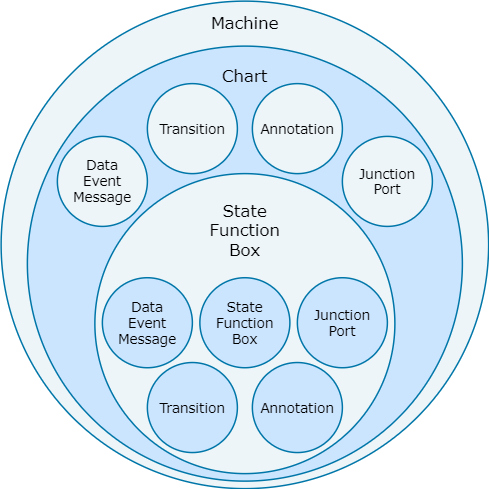Stateflow 객체 개요
Stateflow® 객체는 포함 관계에 따라 계층 구조로 구성됩니다. 즉, 하나의 Stateflow 객체가 다른 Stateflow 객체를 포함할 수 있습니다.

Stateflow 계층 구조에서 최상위 객체는 Stateflow 머신입니다. Stateflow 머신에는 Simulink® 모델의 모든 Stateflow 차트가 포함됩니다.
Stateflow 차트는 상태, 함수, 상자, 데이터, 이벤트, 메시지, 천이, 연결점, 진입 포트와 진출 포트, 주석을 포함할 수 있습니다. 상태, 함수, 상자는 다른 상태, 함수, 상자, 데이터, 이벤트, 메시지, 천이, 연결점, 진입 포트와 진출 포트, 주석을 포함할 수 있습니다. 중첩의 수준은 무한정 계속될 수 있습니다.
그래픽 객체
그래픽 객체를 관리하려면 Stateflow 편집기를 사용합니다. 다음 표에는 각 그래픽 객체 유형과 해당 객체를 추가할 때 사용하는 팔레트 아이콘이 나와 있습니다. 자세한 내용은 Stateflow Editor Operations 항목을 참조하십시오.
그래픽 객체 유형 | 팔레트 아이콘 | 참조 |
|---|---|---|
상태 |
| 상태를 사용하여 동작 모드 표현하기 |
천이 |
| 동작 모드 간 천이 |
연결점 |
| 천이와 연결점을 결합하여 분기 경로 생성하기 |
상자 |
| 상자를 사용하여 차트 객체 그룹화하기 |
Simulink 기반 상태 |
| Create and Edit Simulink Based States |
Simulink 함수 |
| Stateflow 차트에서 Simulink 함수 재사용하기 |
그래픽 함수 |
| 그래픽 함수를 정의하여 논리 패턴 재사용하기 |
MATLAB® 함수 |
| MATLAB 함수를 정의하여 MATLAB 코드 재사용하기 |
진리표 함수 |
| 조합 논리 모델링에 진리표 사용하기 |
이력 연결점 |
| 이력 연결점을 사용하여 이전 하위 상태 활동 재개하기 |
| 진출 연결점 |
| Create Entry and Exit Connections Across State Boundaries |
| 진입 연결점 |
| Create Entry and Exit Connections Across State Boundaries |
| 주석 |
| 차트에서 설명 주석 추가하기 |
| 이미지 |
| 차트에서 설명 주석 추가하기 |
비그래픽 객체
Stateflow 편집기에서 그래픽으로 표시되지 않는 데이터, 이벤트, 메시지 객체를 정의할 수 있습니다. 비그래픽 객체를 관리하려면 기호 창 또는 모델 탐색기를 사용합니다. 자세한 내용은 다음을 참조하십시오.
데이터 객체
Stateflow 차트는 실행을 제어하는 데 사용하는 데이터를 저장하고 가져옵니다. Stateflow 데이터는 자체 작업 공간 내에 위치하지만, Stateflow 머신이 포함된 Simulink 모델이나 애플리케이션처럼 외부에 있는 데이터에도 액세스할 수 있습니다. Stateflow 차트에서 사용하는 데이터라면 내부 데이터이든 외부 데이터이든 모두 정의해야 합니다.
이벤트 객체
이벤트는 Stateflow 차트 전체 또는 차트 내의 개별 동작을 트리거할 수 있는 Stateflow 객체입니다. Stateflow 차트는 이벤트에 응답하여 실행되므로 이벤트를 차트에 지정하고 프로그래밍하여 차트 실행을 제어할 수 있습니다. 이벤트를 보내는 객체의 범위 내에 있는 모든 객체에 이벤트를 브로드캐스트할 수도 있고, 이벤트를 특정 객체한테 보낼 수도 있습니다. 직접 지정한 명시적 이벤트를 정의할 수도 있고, 특정 동작이 수행될 때(예: 상태 진입 시) 발생하는 묵시적 이벤트를 정의할 수도 있습니다. 자세한 내용은 이벤트를 브로드캐스트하여 모델 컴포넌트 동기화하기 항목을 참조하십시오.
메시지 객체
Stateflow 메시지 객체는 데이터를 운반할 수 있도록 대기열에 추가되는 객체입니다. 하나의 Stateflow 차트에서 다른 차트로 메시지를 보내 차트 간에 통신할 수 있습니다. 차트 내에서 로컬 메시지도 보낼 수 있습니다. 사용자가 메시지 데이터의 유형을 정의합니다. Sequence Viewer 블록에서 메시지의 수명선을 볼 수 있습니다. 자세한 내용은 메시지를 전송하여 Stateflow 차트와 통신하기 항목을 참조하십시오.













